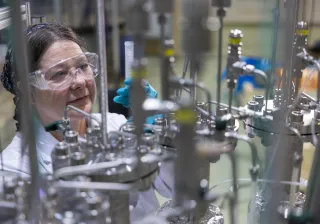Finland’s strategic programme proposal to promote circular economy includes targets and methods for creating circular economy as a new foundation for the national economy. News about the global environment, consumption, as well as the use and adequacy of raw materials are ever more prominent. The state of our environment and our consumer habits are unsustainable, and we face inevitable change in our near future. The circular economy is seen as a solution to these challenges as well as one on the paths towards Sustainable Development Goals which also requires new perspectives and methods: a systemic approach, co-creation and data availability. Companies will be required to implement new, ecosystemic modes of operation, circular design of products and services, approaches for data sharing, as well as new business models. VTT aims to support companies in responding to the challenges of the circular economy: Which methods of the circular economy can be used to create profitable and sustainable business? How can we change the way we plan our products and production processes to match the circular model?
Comprehensive life cycle knowledge is a requirement of a circular economy
Circular design and radical new business models both require a systemic perspective and comprehensive understanding. They are co-created in ecosystems, in which value is produced and shared differently. At best, it’s possible to find new optimal solutions that can improve the ways in which value is created throughout entire value chains, despite the fact that in the short term, the requirements of the circular economy may lead to higher costs for companies. Operating in such ecosystems and coming up with innovative business models, not to mention implementing them, require interaction between different actors – designers, data users as well as environmental experts – to optimise the solutions. Sustainable circular solutions that stay in place for an entire life cycle, as well as supportive business models, will serve to make design more challenging from a content perspective, particularly due to tightening market, environmental and regulatory requirements. To solve these mattes, what’s required of companies is intent, new co-creation models, new expertise, data sharing, and new tools for systematic circular design. The system-level impact of solutions, understanding the life cycle of a product or solution and its dynamics are key to designing and optimising new operating models for a circular economy.
Product design requirements and principles need to be renewed in companies
The circular economy model strongly highlights the need of a systemic approach and the impacts of the life cycle in product and business model design. The circular economy will challenge companies to co-create products in large ecosystems to understand a product’s opportunities and impacts throughout its entire life cycle. It will create an additional need to design services and products to meet the sustainability requirements. It does not, however, require essential changes to how a product’s technical design, such as mechanical design, is carried out, and product details are designed to be a part of a whole. In the future, however, circular business models will create requirements and constraints on technical product design. These design requirements may have to do with the choice of material, disassembly or improving the sustainability of other actors in the value network. To ensure a profitable business at the same time, we must create new ways of working together for companies that enable the creation and comparison of optimal solutions throughout the value network.
Data-related business and technologies for data management and use provide excellent tools to implement the circular economy. Data and digital technologies create opportunities for new ways to integrate technological, economic, environmental, and social perspectives, as well as for creating comprehensive solutions within the system. What becomes even more important is to identify and share essential data, and to make it available and usable, to create new, useful information and knowledge from the data. This data can be used to track product and solution life cycles, circulation as well as energy and material use, among other things. Additionally, this data is an essential part of product identification and product passports, which make it possible to extend a product’s life cycle and enable product and material circulation.
Research to support business and technology
VTT provides, as a multidisciplinary and objective technical research centre, support for companies to understand the challenges and business opportunities in the circular economy. VTT develops new methods and insights, such as on how material can be reused while retaining a product’s performance, how to extend the life of a product and material, and how the impurities in recycled material can be controlled through multiple cycles. VTT’s multidisciplinary research and development work creates a foundation for assessing the opportunities and dependencies in the circular economy in an effective manner, as well as for creating and implementing innovative, circular business models, as well as for managing and utilising data on the product and its use.









